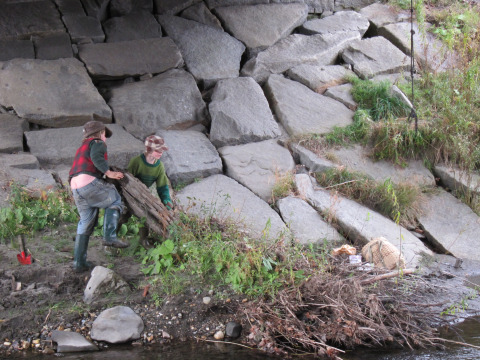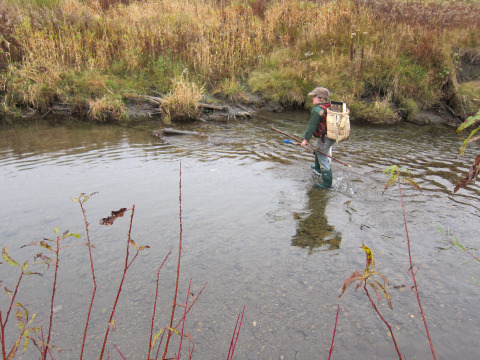It Is What They Do
The boys were up and out before first light to run their trapline, their headlamps bobbing and darting as they waddled down the field under the weight of their provisioned pack baskets. The baskets themselves are a product of their own hands, loaded with axes and traps and lure. Wire and water.
Trapping season opened on Saturday, and they spent the entire weekend (and I do mean every freakin’ hour of daylight) setting traps across our land and Melvin’s. On Sunday morning, I walked the line with them; it took better than two hours. When we got home, we ate breakfast, and the boys headed out again.
This weekend, up to our elbows in piggy bits, Penny and I got to talking about our sons’ learning experiences outside the formalized education system and how so many of those experiences have been enabled simply because they have the time to pursue them. This led to a quick calculation regarding how many hours they would have passed in school, were that to be their fate. For Fin, we tallied up 8400 hours; Rye, being approximately three years younger, would clock in at about half that. That’s before homework and before the 34 hours American children spend drooling in front of the television each week (Fin and Rye watch none). Add in the TV, and you’re talking – over just the past 6 years Fin would have been in school – upwards of 19,000 hours captive to either the classroom or the idiot box. Nineteen thousand. If you figure the boys are awake for about 14 hours each day, that’s 1,357 days or 3.7 years of my older sons’ waking life. The mind boggles.
How much of that time is truly productive, not merely in regards to learning and developing, but in terms of feeding emotion and spirit, in terms of fostering connection and a sense of a child’s place in this world? It’s a rhetorical question, because I don’t know the answer, and I don’t know that there really is an answer. How can you measure such things? I’m not exactly sure, but I strongly suspect pop quizzes, final exams, and mastery of pop culture trivia ain’t it.
After we got good and depressed dwelling on the math of modern childhood, a funk that only copious sampling of our latest batch of maple sausage could remedy (maple syrup, diced onion, garlic, salt, mustard powder and the piece de resistance, a generous splash of our friend Paul’s bathtub wine), we got to talking about what our boys have learned from trapping, all of their own passion and volition. Don’t get me wrong, much of what Fin and Rye learn is facilitated; There’s a pervasive notion that unschooling is about letting your children run wild and directionless, but of course nothing could be further from the truth (I won’t say much more about the subject of facilitated unschooling, because I don’t want to fritter fodder for a future post… crikey… awesomely abundant alliteration, already!). Our children do run wild, as every child should, but there’s a heck of a lot more to it than that.

Mind the crack!
Anyhoo, here’s the list we came up with:
Money management: How many traps they need and can afford, how much to spend on books and lure, how much to save for future needs
Time management: Balancing chores and other responsibilities with running the trapline each morning
Earth Sciences: How the natural world surrounding them works
Biology: Understanding the relationship of animals, their habitat, season, etc
Anatomy: Yeah, I think they got this one nailed
Physical Education: Humping over hill and dale for hours on end, carrying 30-pound packs
Math: Mostly relating to money management, but also considerations of wildlife carrying capacity
Awareness of advertising/corporate messaging: We talk all the time about how the contemporary fur market is dominated by corporate interests selling furs to China, which are purchased by individuals who’ve bought into a fashion trend
Ethics: Using all parts of the animal (newsflash: deep fried ram balls are not all that tasty), giving thanks, not trapping more than they can actually use/consume, using traps designed to minimize pain
Teamwork/cooperation: They do all this together
Geography: Using maps to determine who owns the land they want to trap, understanding topo maps, etc
Reading and Writing: Letters to landowners seeking permission, books on technique, etc
Human Relations: Approaching landowners, and even knocking on doors to ask permission
Success, failure, perseverance: Obvious
As Penny pointed out, they’ve even had the opportunity to memorize useless information just to pass a test, given the oft-inane nature of the so-called “knowledge” one needs to pass the trapper ed certification class (“what clothes should you wear while trapping?”)
My point is not to brag on my boys. They are, like all humans, imperfect creatures, with gaps in knowledge and character that only time can fill (and none of us live long enough to fill them all). I merely wish to make a point I’ve tried to make many a time in this space: Children learn. They do not need to be told to learn, or taught to learn. They sure as hell don’t need to be forced to learn, because it is what they do.
We just need to let them.

Ben Hewitt's Blog
- Ben Hewitt's profile
- 37 followers







